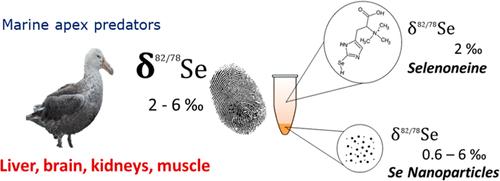当前位置:
X-MOL 学术
›
Environ. Sci. Technol.
›
论文详情
Our official English website, www.x-mol.net, welcomes your
feedback! (Note: you will need to create a separate account there.)
First-Time Isotopic Characterization of Seleno-Compounds in Biota: A Pilot Study of Selenium Isotopic Composition in Top Predator Seabirds
Environmental Science & Technology ( IF 10.8 ) Pub Date : 2024-07-17 , DOI: 10.1021/acs.est.4c02319 Claudia Marchán-Moreno 1 , Pascale Louvat 1 , Maite Bueno 1 , Sylvain Berail 1 , Warren T Corns 2 , Yves Cherel 3 , Paco Bustamante 4 , David Amouroux 1 , Zoyne Pedrero 1
Environmental Science & Technology ( IF 10.8 ) Pub Date : 2024-07-17 , DOI: 10.1021/acs.est.4c02319 Claudia Marchán-Moreno 1 , Pascale Louvat 1 , Maite Bueno 1 , Sylvain Berail 1 , Warren T Corns 2 , Yves Cherel 3 , Paco Bustamante 4 , David Amouroux 1 , Zoyne Pedrero 1
Affiliation

|
This study pioneers the reporting of Se isotopes in marine top predators and represents the most extensive Se isotopic characterization in animals to date. A methodology based on hydride generation─multicollector inductively coupled plasma mass spectrometry─was established for such samples. The study was conducted on various internal organs of giant petrels (Macronectes spp.), encompassing bulk tissues (δ82/78Sebulk), distinct Se-specific fractions such as selenoneine (δ82/78SeSEN), and HgSe nanoparticles (δ82/78SeNPs). The δ82/78Sebulk results (2.0–5.6‰) offer preliminary insights into the fate of Se in key internal organs of seabirds, including the liver, the kidneys, the muscle, and the brain. Notably, the liver of all individuals was enriched in heavier Se isotopes compared to other examined tissues. In nanoparticle fraction, δ82/78Se varies significantly across individuals (δ82/78SeNPs from 0.6 to 5.7‰, n = 8), whereas it exhibits remarkable consistency among tissues and individuals for selenoneine (δ82/78SeSEN, 1.7 ± 0.3‰, n = 8). Significantly, there was a positive correlation between the shift from δ82/78Sebulk to δ82/78SeSEN and the proportion of Se present as selenoneine in the internal organs. This pilot study proves that Se species-specific isotopic composition is a promising tool for a better understanding of Se species fate, sources, and dynamics in animals.
中文翻译:

生物群中硒化合物的首次同位素表征:顶级捕食性海鸟硒同位素组成的初步研究
这项研究开创了海洋顶级捕食者硒同位素的报道,代表了迄今为止动物中最广泛的硒同位素特征。针对此类样品建立了基于氢化物发生的方法(多接收器电感耦合等离子体质谱法)。该研究是在巨海燕 ( Macromectes spp.) 的各种内脏器官上进行的,包括大量组织 (δ 82/78 Se大量)、不同的 Se 特异性组分,如硒烯 (δ 82/78 Se SEN ) 和 HgSe 纳米粒子 ( δ 82/78 Se NPs )。 δ 82/78 Se批量结果 (2.0–5.6‰) 初步了解了海鸟关键内脏器官(包括肝脏、肾脏、肌肉和大脑)中硒的命运。值得注意的是,与其他检查组织相比,所有个体的肝脏都富含较重的硒同位素。在纳米粒子部分中,δ 82/78 Se 在个体之间存在显着差异(δ 82/78 Se NPs从 0.6 到 5.7‰, n = 8),而其在组织和个体之间表现出显着的硒烯氨酸一致性(δ 82/78 Se SEN , 1.7 ± 0.3‰, n = 8)。值得注意的是,从 δ 82/78 Se体积到 δ 82/78 Se SEN的转变与内脏器官中以硒烯氨酸形式存在的 Se 比例之间存在正相关。这项初步研究证明,硒物种特异性同位素组成是一个有前途的工具,可以更好地了解动物中硒物种的命运、来源和动态。
更新日期:2024-07-17
中文翻译:

生物群中硒化合物的首次同位素表征:顶级捕食性海鸟硒同位素组成的初步研究
这项研究开创了海洋顶级捕食者硒同位素的报道,代表了迄今为止动物中最广泛的硒同位素特征。针对此类样品建立了基于氢化物发生的方法(多接收器电感耦合等离子体质谱法)。该研究是在巨海燕 ( Macromectes spp.) 的各种内脏器官上进行的,包括大量组织 (δ 82/78 Se大量)、不同的 Se 特异性组分,如硒烯 (δ 82/78 Se SEN ) 和 HgSe 纳米粒子 ( δ 82/78 Se NPs )。 δ 82/78 Se批量结果 (2.0–5.6‰) 初步了解了海鸟关键内脏器官(包括肝脏、肾脏、肌肉和大脑)中硒的命运。值得注意的是,与其他检查组织相比,所有个体的肝脏都富含较重的硒同位素。在纳米粒子部分中,δ 82/78 Se 在个体之间存在显着差异(δ 82/78 Se NPs从 0.6 到 5.7‰, n = 8),而其在组织和个体之间表现出显着的硒烯氨酸一致性(δ 82/78 Se SEN , 1.7 ± 0.3‰, n = 8)。值得注意的是,从 δ 82/78 Se体积到 δ 82/78 Se SEN的转变与内脏器官中以硒烯氨酸形式存在的 Se 比例之间存在正相关。这项初步研究证明,硒物种特异性同位素组成是一个有前途的工具,可以更好地了解动物中硒物种的命运、来源和动态。











































 京公网安备 11010802027423号
京公网安备 11010802027423号